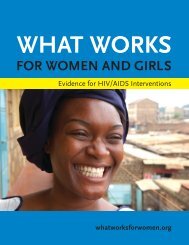Global Tuberculosis Report -- 2012.pdf
Global Tuberculosis Report -- 2012.pdf
Global Tuberculosis Report -- 2012.pdf
Create successful ePaper yourself
Turn your PDF publications into a flip-book with our unique Google optimized e-Paper software.
FIGURE 5.12 Funding required for DOTS and MDR-TBin the <strong>Global</strong> Plan 2011-2015 comparedwith projections of potential funding fromdomestic sources, for six country groupsUS$ billions (current)BRCS a4.03.02.01.00Other HBCs1.00.80.60.40.20Low-income countries0.80.60.40.20aBrazil, Russian Federation, China and South Africa (BRICS excluding India)bThe seven countries included in this group are Armenia, Georgia, Kyrgyzstan,Republic of Moldova, Tajikistan, Ukraine and Uzbekistan. Of the fundingavailable in 2012, approximately half is accounted for by Ukraine. The countriesin this group continue to hospitalize TB patients for lengthy periods of time,while in the <strong>Global</strong> Plan it was assumed that reliance on inpatient hospital carein the European Region would be progressively reduced between 2006 and 2015to an average of 60 days per patient with drug-susceptible TB by 2015. Thisexplains why the funding amounts estimated to be needed in the <strong>Global</strong> Plan arelower than the funding available in this group of countries.cAssumes that: 1) international donor funding received by BRICS in 2011 issubstituted by domestic sources; and 2) domestic funding for TB care and controlin all low and middle-income countries will keep pace with IMF forecasts ofgrowth in GDP per capita.0.50.40.30.20.100.60.40.200.30.20.10IndiaSeven other low- and middle-incomeEuropean countries with a high burdenof MDR-TB bLow-income countries excluding HBCs2011 2012 2013 2014 2015 2011 2012 2013 2014 2015Funding required for DOTS and MDR−TBFunding required for DOTSFunding required for MDR−TBFunding forecast to be available from domestic sources ctreatment of MDR-TB, for which the funding requirementwas estimated at US$ 1 billion in 2011, rising toUS$ 1.9 billion in 2015. The funding required for collaborativeTB/HIV activities (see Chapter 7) increases to aboutUS$ 1 billion by 2015, mostly (about 90% of the total) forantiretroviral therapy for HIV-positive TB patients thatwould be funded via HIV programmes (not NTPs).The funding requirements set out in the <strong>Global</strong> Planare considerably more than the funding amounts reportedby countries. For example, the funding required in 2015according to the <strong>Global</strong> Plan is about US$ 2 billion morethan the funding reported to be available in 2013. 1 In thiscontext – and with international funding constrainedby economic stagnation or recession in traditional donorcountries – assessing the funding that can be mobilizedfrom domestic sources is of increasing importance.Figure 5.12 shows estimates of the funding required fortreatment of TB and MDR-TB in the <strong>Global</strong> Plan, and forselected groupings of countries defined by their TB burdenand income level. Amounts for collaborative TB/HIVactivities are deliberately excluded because ART, the mainintervention in terms of cost, is not funded through NTPs.It is therefore not appropriate to compare funding needsfor collaborative TB/HIV activities with funding reportedby NTPs. Also shown in Figure 5.12 are projections of thefunding that could be mobilized from domestic sources ineach country group, on the assumption that: (i) internationaldonor funding received by BRICS in 2011 is substitutedby domestic sources; and (ii) domestic allocationsfor TB care and control in all low- and middle-incomecountries will keep pace with IMF forecasts of growth inGDP per capita.The data shown in Figure 5.12 provide insights thatcould inform future discussions about investments in TBcare and control, including prioritization of donor fundingamong countries and interventions and targets forresource mobilization. For example:● There is domestic capacity to fund the investmentsneeded for basic TB care and control (DOTS) in BRICS.● An increase in domestic allocations for TB care andcontrol in line with forecast growth in GDP per capitawould be sufficient to mobilize the funding needed fordiagnosis and treatment of MDR-TB in Brazil, the RussianFederation, China and South Africa (all of whichare upper middle-income countries).● In India, without growth in domestic allocations forTB above forecast growth in GDP per capita, aboutUS$ 0.1 billion per year is needed from donor sources.1This is excluding amounts for TB/HIV that are mostly for ARTfunded through HIV programmes, and allowing for fundingin the 34 countries considered in the <strong>Global</strong> Plan that are notin the group of 115 countries for which data were available for2011 or 2012 (Table 5.1). It is anticipated that most of the fundingfor TB/HIV interventions will need to come from internationaldonors.64 GLOBAL TUBERCULOSIS REPORT 2012
















